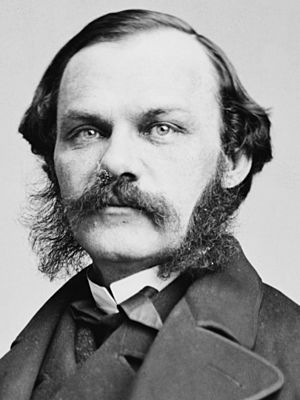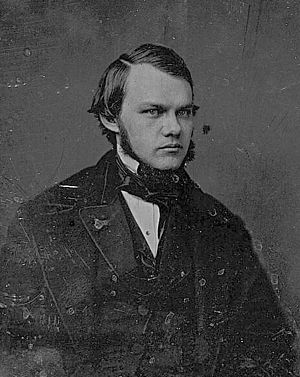Henry Jarvis Raymond facts for kids
Quick facts for kids
Henry Jarvis Raymond
|
|
|---|---|
 |
|
| Lieutenant Governor of New York | |
| In office 1855–1856 |
|
| Governor | Myron H. Clark |
| Preceded by | Sanford E. Church |
| Succeeded by | Henry R. Selden |
| Member of the U.S. House of Representatives from New York's 6th district |
|
| In office March 4, 1865 – March 3, 1867 |
|
| Preceded by | Elijah Ward |
| Succeeded by | Thomas E. Stewart |
| 2nd Chairman of the Republican National Committee | |
| In office 1864–1866 |
|
| Preceded by | Edwin D. Morgan |
| Succeeded by | Marcus L. Ward |
| Member of the New York State Assembly from the New York County, 7th district |
|
| In office January 1, 1850 – December 31, 1851 |
|
| Preceded by | Abraham Van Orden |
| Succeeded by | Freeborn G. Luckey |
| Personal details | |
| Born | January 24, 1820 Livingston County, New York |
| Died | June 18, 1869 (aged 49) New York City, New York |
| Political party | Republican |
| Spouse | Juliette Weaver |
| Children | Edward Henry Raymond Mary Elizabeth Raymond Lucy Margaret Raymond Henry Warren Raymond Walter Jarvis Raymond Aimee Juliette Arteniese Raymond Arthur William Raymond |
| Parents | Jarvis Raymond Lavinia Brockway |
| Alma mater | Genesee Wesleyan Seminary University of Vermont Columbia Law School |
| Occupation | Writer, Editor, Politician, Publisher and Founder of The New York Times |
Henry Jarvis Raymond (January 24, 1820 – June 18, 1869) was an important American journalist and politician. He is best known for co-founding The New York Times newspaper with George Jones.
Raymond also held several important political roles. He was a member of the New York State Assembly, the Lieutenant Governor of New York, and even served in the U.S. House of Representatives. Because of his big role in starting the Republican Party, some people call him the "godfather of the Republican Party."
Contents
About Henry Jarvis Raymond
Early Life and Family
Henry Jarvis Raymond was born on January 24, 1820. His family lived on a farm near Lima, New York. His parents were Lavinia Brockway and Jarvis Raymond. He was their oldest child.
Education and Career Start
Henry showed he was very smart from a young age. People said he could read by age three and give speeches by age five! When he was twelve, he went to the Genesee Wesleyan Seminary in Lima, New York. This school was started by the Methodist Episcopal Church.
He later graduated with high honors from the University of Vermont in 1840. After college, from 1841 to 1851, Raymond worked for different newspapers. He was a journalist and editor for papers like Horace Greeley's New York Tribune.
He met George Jones while working at the Tribune. They often talked about starting their own newspaper. In 1851, Raymond convinced Jones to become his partner. They wanted to create a new paper that would report the news in a fair and neutral way.
Founding The New York Times
In 1851, Henry Raymond formed a company called Raymond, Jones & Company, Inc. Together, they founded The New York Times. Raymond was the newspaper's editor until he passed away.
Marriage and Children
On October 24, 1843, Henry Raymond married Juliette Weaver in Winooski, Vermont. Henry and Juliette had seven children together.
Their son, Henry Warren Raymond (1847–1925), graduated from Yale College and later from Columbia University School of Law. He worked as a reporter for The New York Times for a few years.
Their daughter, Aimee Juliette Arteniese Raymond (1857–1903), became a doctor, writer, and editor. She graduated from New York Medical College in 1889.
Henry Raymond's Political Life
New York State Politics
Raymond was a member of the New York State Assembly in 1850 and 1851. In 1851, he was chosen to be the Speaker of the Assembly.
He was part of the Whig Party, which was against slavery. In 1854, he was chosen as the Whig candidate for Lieutenant Governor of New York. He won the election and served as lieutenant governor from 1855 to 1856.
Henry Raymond played a big part in forming the Republican Party. He wrote an important message called the "Address to the People." This message was adopted by the Republican organizing meeting in Pittsburgh in 1856. In 1862, he was again the Speaker of the New York Assembly.
National Politics
Raymond was one of the first people to suggest a kind and fair approach to the Southern states after the Civil War. He disagreed with the Radical Republicans, who wanted to punish the South more harshly.
In 1865, he was a delegate at the National Republican Convention. He became the Chairman of the Republican National Committee. From 1865 to 1867, he served as a member of the U.S. House of Representatives.
In December 1865, he spoke out against the idea that states which had left the Union should not be allowed back easily. Raymond believed that these states never truly left the Union because their acts of leaving were not valid. He agreed with the President that the states should be restored to their normal place.
Because he spoke against the Radical Republicans, Raymond lost some support within the Republican Party. He was removed from his role as chairman of the Republican National Committee in 1866. He then left public life in 1867 and focused on his newspaper work until he died.
Journalism and The New York Times
Henry Raymond started his journalism career at Horace Greeley's Tribune. He also gained experience editing the Courier and Enquirer.
With help from friends, Raymond raised a lot of money to start The New York Times on September 18, 1851. He wanted the Times to be different from other newspapers. He aimed for a middle ground, not being too biased like some, nor completely neutral like others.
In the very first issue of the Times, Raymond said his goal was to write in calm and fair language. He wanted to avoid getting angry often. He believed there were few things worth getting angry about, and anger wouldn't make them better. He also promised to avoid using harsh words in arguments. His newspaper articles were usually careful, fair, and well-written.
President Lincoln himself said, "The Times, I believe, is always true to the Union." This showed how much Lincoln trusted the newspaper.
Raymond's balanced approach was clear during the time between Lincoln's election and the start of the Civil War. He wrote that the newspaper would stand by the U.S. Constitution. He said they would not make a new one, nor let anyone destroy the existing one. He stated they did not want war, but would fight only to defend the Constitution.
From the attack on Fort Sumter to the end of the war, The New York Times strongly supported President Lincoln. The newspaper was determined that the United States must stay united.
Books and Speeches
Henry Raymond was also a very good public speaker. One of his most famous speeches was given to welcome the Hungarian leader Lajos Kossuth. Raymond supported Kossuth's cause during his visit to New York City in December 1851.
Besides his work with The New York Times, he wrote several books. These included:
- A Life of Daniel Webster (1853)
- Political Lessons of the Revolution (1854)
- A History of the Administration of President Lincoln (1864)
- The Life and Public Services of Abraham Lincoln (1865)
Death
Henry Raymond passed away in New York City, New York, on June 18, 1869. He died from a heart attack. He was buried in Brooklyn's Green-Wood Cemetery.
See also
In Spanish: Henry Jarvis Raymond para niños


